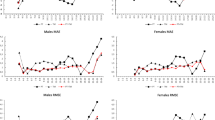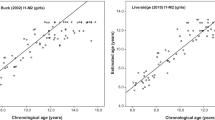Abstract
The methodology used to identify individuals in forensic anthropology requires a minimum degree of precision and accuracy and should be based on identified and representative samples. Achievement of these objectives in infant skeletons is hampered by the scarcity of appropriate samples. The dental age estimation methods of Liversidge et al. (Am J Phys Anthropol 90: 307–313, 1993) and Deutsch et al. (Growth 49: 207–17, 1985) were applied to the Granada osteological collection of identified infants (Granada, Spain) in order to evaluate its applicability in a Mediterranean population. Significant differences were found between the estimated and real ages in both cases. Based on the measurements obtained in 140 fetuses and infants, new regression formulas were developed to estimate age from the metric study on deciduous teeth. Independent functions are provided for each deciduous maxillary and mandibular tooth in each sex, along with the margin of error (95 % confidence interval). These formulas appear to offer one of the best methods available for estimating the age of Mediterranean infants in forensic anthropology settings.


Similar content being viewed by others
References
Aka PS, Canturk N, Dagalp R, Yagan M (2009) Age determination from central incisors of fetuses and infants. Forensic Sci Int 184(1–3):15–20
AlQahtani SJ, Hector MP, Liversidge HM (2010) Brief communication: the London atlas of human tooth development and eruption. Am J Phys Anthropo 142:481–490
Aleman I, Irurita J, Valencia AR, Martinez A, Lopez-Lazaro S, Viciano J, Botella MC (2012) Brief communication: the Granada osteological collection of identified infants and young children. Am J Phys Anthropol 149:606–610
Cameriere R, Flores-Mir C, Mauricio F, Ferrante L (2007) Effects of nutrition on timing of mineralization in teeth in a Peruvian sample. Ann Hum Biol 34(5):547–556
Cardoso HF (2006) Brief communication: the collection of identified human skeletons housed at the Bocage Museum (National Museum of Natural History), Lisbon, Portugal. Am J Phys Anthropol 129:173–176
Cardoso HF (2007) Accuracy of developing tooth length as an estimate of age in human skeletal remains: the deciduous dentition. Forensic Sci Int 172:17–22
Cardoso HF (2007) Environmental effects on skeletal versus dental development: using a documented subadult sample to test a basic assumption in human osteological research. Am J Phys Anthropo 132:223–233
Christensen AM, Crodwer CM (2009) Evidentiary standards for forensic anthropology. J Forensic Sci 54:6
Cunha E, Baccino E, Martrille L, Ramsthaler F, Prieto J, Schuliar Y, Lynnerup N, Cattaneo C (2009) The problem of aging human remains and living individuals: a review. Forensic Sci Int 193:1–13
Demirjian A, Goldstein H, Tanner JM (1973) A new system of dental age assessment. Hum Biol 45(2):211–217
Deutsch D, Tam O, Stack MV (1985) Postnatal changes in size, morphology and weight of developing postnatal deciduous anterior teeth. Growth 49(2):207–217
Franklin D (2010) Forensic age estimation in human skeletal remains: current concepts and future directions. Leg Med (Tokyo) 12:1–7
Lewis ME (2007) The bioarchaeology of children, 2nd edn. Cambridge University Press, Cambridge
Liversidge HM, Dean MC, Molleson TI (1993) Increasing human tooth length between birth and 5.4 years. Am J Phys Anthropol 90:307–313
Martin AA, Luna JD (1989) Bioestadística para las Ciencias de la Salud, 2ath edn. Norma, Madrid
Minier M, Maret D, Dedouit F, Vergnault M, Mokrane FZ, Rousseau H, Adalian P, Telmon N, Rougé D (2013) Fetal age estimation using MSCT scans of deciduous tooth germs. Int J Legal Med. doi:10.1007/s00414-013-0890-z
Molleson T, Cox M, Waldron AH, Whittaker DH (1993) The Spitalfields project, volume 2: the anthropology, the middling sort. CBA research report 86. Council for British Archaeology, York
Moorrees CF, Fanning EA, Hunt EE Jr (1963) Age variation of formation stages for ten permanent teeth. J Dent Res 42:490–502
Mörnstad H, Staaf V, Welander U (1994) Age estimation with the aid of tooth development: a new method based on objetive measurements. Scand J Dent Res 102(3):137–143
Olze A, Niekerk P, Ishikawa T, Zhu BL, Schulz R, Maeda H, Schmeling A (2007) Comparative study on the effect of ethnicity on wisdom tooth eruption. Int J Legal Med 121:445–448
Olze A, Hertel J, Schulz R, Wierer T, Schmeling A (2012) Radiographic evaluation of Gustafson’s criteria for the purpose of forensic age diagnostics. Int J Legal Med 126(4):615–621
Pelsmaekers B, Loos R, Carels C, Derom C, Vlietinck R (1997) The genetic contribution to dental maturation. J Dent Res 76(7):1337–1340
Saunders SR (2008) Juvenile skeletons and growth-related studies. In: Katzenberg MA, Saunders SR (eds) Biological anthropology of the human skeleton. Wiley, New York, pp 117–146
Scheuer LY, Black S (2004) The juvenile skeleton. Elsevier, Londres
Schour IY, Massler M (1941) The development of the human dentition. J Am Dent Assoc 28:1153–1160
Stack MV (1967) Vertical growth rates of the deciduous teeth. J Dent Res 46(5):879–882
Thevissen PW, Galiti D, Willems G (2012) Human dental age estimation combining third molar(s) development and tooth morphological age predictor. Int J Legal Med 126(6):883–887
Ubelaker DH (1989) Human skeletal remains: excavation, analysis, interpretation. Taraxacum, Washington
Ubelaker DH (2008) Forensic anthropology: methods and diversity of applications. in: biological anthropology of the human skeleton, Secondth edn. Wiley, Hoboken, pp 41–71
van Waes HJ, Stöckli MPW (2002) Atlas de Odontología Pediátrica. Masson, Barcelona
Acknowledgments
The authors are grateful to D. Jose Antonio Muñoz, Managing Director; Maribel Martín, coordinator of services; and all EMUCESA staff at the San Jose cemetery in Granada for their invaluable assistance; to the Magistrate Judge (Court of First Instance no. 5), responsible for the Registry Office of Granada; to Armando González Martín for his collaboration; and to two anonymous reviewers for their insights and suggestions. This work has been supported by the European Commission under project MEPROCS (ref. FP7-SEC-2011-1, GA Number 285624), by the Spanish Ministerio de Economía y Competitividad under project SOCOVIFI2 (ref. TIN2012-38525-C02-01/TIN2012-38525-C02-02), and by the Andalusian Dpt. of Innovación, Ciencia y Empresa (ref. P11-TIC-7745), including funding from the European Development Regional Funds.
Conflict of interest
The authors declare that they have no conflict of interest.
Author information
Authors and Affiliations
Corresponding author
Rights and permissions
About this article
Cite this article
Irurita Olivares, J., Alemán Aguilera, I., Viciano Badal, J. et al. Evaluation of the maximum length of deciduous teeth for estimation of the age of infants and young children: proposal of new regression formulas. Int J Legal Med 128, 345–352 (2014). https://doi.org/10.1007/s00414-013-0903-y
Received:
Accepted:
Published:
Issue Date:
DOI: https://doi.org/10.1007/s00414-013-0903-y




